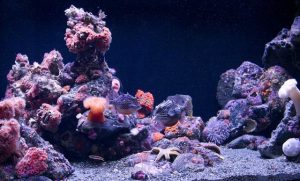
This impressive work in progress, housing both Northeast Pacific and Southern Australian species, is reportedly “filling in” nicely. Photo by Steve Weast.
Nowadays, only the most senior aquarists amongst us can recall the days of old when the marine aquarium hobby was in its primacy–when undergravel filters were sophisticated water treatment devices, condy anemones were hot, novel “imports,” and success was proclaimed whenever a purchase was still alive by the time the check cleared. In those days, North American and European hobbyists alike were not at all averse to exploiting local resources for use as subjects of display in their home aquaria; these animals came to be regarded (in the context of the time) as quite durable, quite accessible, and quite expendable.
All the same, attention shifted sharply towards tropical species as availability increased and prices dropped with innovations in the transport of live animals. Whilst the freshwater “native” aquarium niche sustained a steady following (as evidenced by many longstanding clubs, magazine columns, and so on), its saltwater counterpart was ultimately eclipsed by the reef aquarium craze of the mid-1980s. The most absurd paradox in all of this: the greater part of this generation of aquarists has a much better familiarity with various far-flung marine habitats than with those under its own charge.
In a strange full-circle of sorts, many temperate marine species–some of which may even occur locally–have thusly become the epitome of aquarium exotica. Albeit most modern aquarists now reject the notion of any natural marine resource as somehow being expendable, numerous hobbyists are once again placing a high value on temperate livestock, not merely on account of its accessibility and durability, but because it is, in its own right, quite awesome.
A resurgent interest in temperate marine aquaria has accordingly emerged and continues to grow. What is clear, however, from the examples provided by notable contemporary sources such as aquariacentral.com/forums, oregonreef.com, or jonolavsakvarium.com, is that these are not your grandfather’s aquaria; advances in aquarium refrigeration, filtration, lighting, dosing, feeding, etc. have multiplied the possibilities for temperate applications every bit as much as they have for tropical applications. Undoubtedly, some of the most significant improvements in the culture of temperate marine invertebrates (which hail predominately from poorly-illuminated, nutrient-rich waters) have come through gains made in the NPS (non-photosynthetic) aquarium movement.
From amongst the myriad of invertebrate creatures that present potential in this capacity, a handful of azooxanthellate North American West Coast-endemic cnidarians (i.e., the hydrozoans, anthozoans, and scyphozoans) continue to receive the most attention by temperate marine aquarists. The focus of this discussion is on a selection of hydrozoans (hydroids, hydrocorals, etc.) and anthozoans (sea anemones, sea pens, stony corals, gorgonians, etc.); scyphozoans (jellyfish) require specialized care that is beyond the scope of this discussion and thusly have been excluded.

This live seafood holding system features some useful built-in components such as a powerful refrigeration unit; it has been modified to accommodate additional components such as an auto-feeder (housed in a minifridge) and a sump (made from a common beer cooler). Photo by Stu Wobbe.

Lighting in true NPS systems is, of course, completely unnecessary, thought moderate levels of illumination may be used as desired to enhance viewing. Photo by Stu Wobbe.
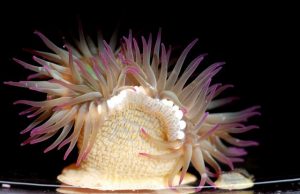
The relatively intense lighting preferred by zooxanthellate cnidarians (such as this Anthopleura elegantissima) is stressful to many of their cryptic and deepwater azooxanthellate brethren; these are best maintained separately. Photo by Jamie Canepa.
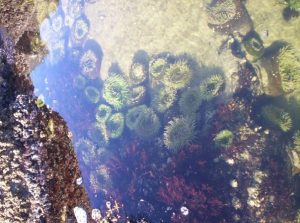
Some zooxanthellate cnidaria (such as these Anthopleura xanthogrammica) might be successfully maintained (perhaps along with surfgrass and macroalgae) in the refugium of a NPS system. Photo by Kenneth Wingerter.

A refrigerated auto-feeder; this DIY unit features 1) a compact, programmable, multi-line food doser, 2) a magnetic stirrer to keep cyclopeese in suspension, 3) an independent vodka doser, and 4) a three-way motorized ball valve to divert return flow directly back to the sump during feeding. Photo by Steve Weast.
Selected Species
Pink-mouth hydroid (Tubularia crocea)
- Class Hydrozoa
- Description: Colonies 1′ (30 cm) wide, 5″ (12.5 cm) tall. Polyps grouped on a creeping stem. Whorl of tentacles on a disproportionately large head.
- Habitat/range: Can be found anywhere in continuously submerged shallows such as tide pools, wharf pilings, and even boat hulls, down to 50′ (15m). Washington to California.
- Collection/care: May be lifted from flat surfaces en mass using a plastic hair comb, but is best taken intact on rock. Place in moderate current and feed zooplankton such as Artemia nauplii, Euplotes, and rotifers.
Purple stylasterine (Stylantheca porphyra)
- Class Hydrozoa
- Description: Colonies 6″ (15 cm) wide, 1/8″ (0.3 cm) tall. Lavender to pastel purple growth in thin calcareous sheets. Each tiny, mouthless polyp in a scalloped pit.
- Habitat/range: Protected, shady vertical rock faces from under the low-tide line to 100′ (30 m). British Columbia to Central California.
- Collection/care: Very difficult to remove from rock surface, best taken whole on rock. Ideally glued/epoxied onto a rock wall or ceiling of cave as to avoid smothering by algae and detritus. Place in strong current and feed zooplankton such as Artemia nauplii, rotifers, and appropriate liquid diets.
California hydrocoral (Stylaster californicus)
- Class Hydrozoa
- Description: Colonies 24″ (61 cm) wide, 12″ (30.5 cm) tall. Pink to dark blue growth in broadly branching calcareous projections. Each tiny mouthless polyp in a scalloped pit.
- Habitat/range: Protected, shady vertical rock faces from under the low-tide line to 100′ (30 m). Northern California to Baja California.
- Collection/care: Very difficult to remove from rock surface, best taken whole on rock. Ideally glued/epoxied onto a rock wall or on ceiling of cave as to avoid smothering by algae and detritus. Place in strong current and feed zooplankton such as Artemia nauplii, rotifers, and appropriate liquid diets.
Orange sea pen (Ptilosarcus gurneyi)
- Class Anthozoa
- Subclass Octocorallia
- Description: Colonies 20″ (50 cm) tall, 4″ (10 cm) wide. Stout, plume-like proximal stalk with midrib bearing 20 pairs of side branches. Highly swollen, burrowing peduncle anchors the colony in soft bottoms. If slightly disturbed will emit bioluminescence; if severely disturbed will completely withdraw into substrate.
- Habitat/range: Found in sandy or muddy flats. Very rarely intertidal, usually subtidal to 100′ (30 m). British Columbia to Central California.
- Collection/care: Fairly easily dug out from sand. Capable of reburying itself in the aquarium. Provide at least six inches of clean sand. Appreciates company of sifters, which help to prevent substrate from turning anoxic. Strong, unidirectional water flow is ideal; colony will turn to face current. Offer frequent feedings of zooplankton such as Artemia nauplii.
White sea pen (Virgularia spp.)
- Class Anthozoa
- Subclass Octocorallia
- Description: Colonies 12″ (30 cm) tall, 4″ (10 cm) wide. Slender white stalk and branches. Slightly swollen, burrowing peduncle anchors the colony in soft bottoms. If slightly disturbed will emit bioluminescence; if severely disturbed will completely withdraw into substrate.
- Habitat/range: Found in sandy or muddy flats. 50′ (15 m) and deeper. British Columbia to Baja California.
- Collection/care: Fairly easily dug out from sand. Not capable of reburying itself in the aquarium. Needs as much as 12 inches of clean sand; best held in place within perforated basket and buried with course to progressively finer grades of sand. Appreciates company of sifters, which help to prevent substrate from turning anoxic. Offer frequent feedings of zooplankton such as Artemia nauplii.
Western sea pansy (Renilla koellikeri)
- Class Anthozoa
- Subclass Octocorallia
- Description: Colonies 3″ (7.5 cm) tall, 3 1/4″ (8.5 cm) wide. Flattended, heart-shaped, rosy to pale purple stalk with polyps emerging from top and slightly swollen, burrowing peduncle extending into soft bottom from below. Will emit bioluminescence if disturbed.
- Habitat/range: Found in shallow waters on sandy or muddy flats. Southern California to Baja California.
- Collection/care: Easily dug out from sand. Capable of reburying itself in the aquarium. Provide at least two inches of clean sand. Offer frequent feedings of zooplankton such as Artemia nauplii.
Red soft coral (Gersemia rubiformis)
- Class Anthozoa
- Subclass Octocorallia
- Description: Colonies 6″ (15 cm) tall, 3″ (7.5 cm) wide. Red or orange fleshy lumps or club-shaped lobes covered with numerous small white polyps. Habitat/range: Found on rocks (rarely intertidal), offshore pinnacles, and occasionally on pilings from just below the low-tide line to 50′ (15 m). Alaska to Northern California.
- Collection/care: Can be carefully pried from rock with a butter knife and secured to new surface, but is best taken whole on rock. Colonies should be placed so that they project outward into a very strong current. Maintain excellent water quality and full salinity. Requires rather heavy feedings of zooplankton such as Artemia nauplii.
Muricea gorgonian (Muricea spp.)
- Class Anthozoa
- Subclass Octocorallia
- Description: Colonies 3′ (90 cm) tall, 3″ (7.5 cm) wide. Highly branched, flattening at the point of origin into a single plane. Polyps arise from tubular, highly reinforced pores that give branches a bumpy appearance.
- Habitat/range: Found on large rocks and hard bottoms, as well as wharf pilings, pipelines, and wrecks, from 50′ (15 m) to 100′ (30 m). Southern California to Baja California.
- Collection/care: Can be clipped from surface at the base, but is best taken whole on a chipped-away section of substrate. Colonies should be well-secured in an upright position perpendicular (or very nearly perpendicular) to a strong current. Maintain low temperatures, excellent water quality, and full salinity. Requires regular heavy feedings of zooplankton such as Artemia nauplii and appropriate liquid diets.

Excessive use of lighting in a typically nutrient-rich temperate system will result in nuisance algal blooms, which can quickly smother a gorgonian to death. Photo by Stu Wobbe.
Tube-dwelling anemone (Pachycerianthus fimbriatus)
- Class Anthozoa
- Subclass Hexacorallia
- Description: 14″ (35 cm) tall, 8” (20 cm) wide. Double set of golden brown to black or dark purple tentacles. Secretes a parchment-like tube (discharged nematocysts) in soft substrates into which it can quickly withdraw if disturbed.
- Habitat/range: Found in sandy or muddy flats. Rarely intertidal zone, mainly shallow subtidal to 100′ (30m). Alaska to Baja California.
- Collection/care: Burrow can be quite deep, so properly extracting the specimen might require much digging. Not capable of reburying itself in the aquarium; all but the top few inches should be covered with sand. Tentacles can extend quite far, so allow plenty of space when between tankmates. Will accept a wide variety of foods such as adult Artemia, Mysis, finely chopped prawn, fish, or squid.
Plumose anemone (Metridium senile)
- Class Anthozoa
- Subclass Hexacorallia
- Description: 18″ (46 cm) tall, 9″ (23 cm) wide. Very smooth throughout, with numerous (up to 1,000) fine tentacles. Typically bright white, though yellow, peach, and brown examples are not uncommon.
- Habitat/range: Found in sheltered rocky areas and frequently wharf pilings near low-tide line, occasionally into deeper subtidal zone. Fairly tolerant of brackish conditions.
- Collection/care: Somewhat delicate; carefully scrape from surface with a credit card. May reproduce in the aquarium by way of pedal laceration. Demands strong water movement; will remain closed if water movement is insufficient; if a ring of slime develops around the base of the column, increase flow. Best primed with the scent of a small amount of liquid food before full feeding; offer generous amounts of very fine foods such as Artemia nauplii and appropriate liquid diets.
Fish-eating anemone (Urticina piscivora)
- Class Anthozoa
- Subclass Hexacorallia
- Description: 8″ (20 cm) tall, 10″ (25 cm) wide. Red column with white tentacles, often on a red-banded, golden oral disc.
- Habitat/range: Found on all exposed hard surfaces, mostly on sides of boulders, from very low intertidal to 160′ (48 m). Northern Washington to Southern California.
- Collection/care: Carefully scrape from surface with a credit card. Caution should be exercised when introducing fish, which it is capable of catching with its very powerful nematocysts. Maintain low temperatures and full salinity. Will accept a wide variety of foods such as whole prawn, fish, or squid.
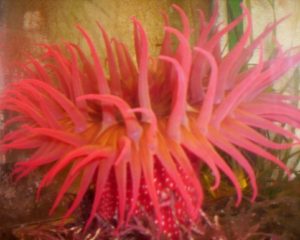
The white-spotted rose anemone (Urticina lofotensis) has enamored marine aquarists for half of a century. Photo by Kenneth Wingerter.
White-spotted rose anemone (Urticina lofotensis)
- Class Anthozoa
- Subclass Hexacorallia
- Description: 6″ (15 cm) tall, 4″ (10 cm) wide. Crimson red with white speckles over column; often with intricate radiating bands on oral disc, but with no markings on tentacles.
- Habitat/range: Found mainly on sheltered areas, including floats and wharf pilings, from around the low-tide line to 50′ (15 m). Washington to Southern California.
- Collection/care: Carefully scrape from surface with a credit card. Sometimes sold (inappropriately) as a tropical species. Heavier feedings can result in very high growth rates. Will accept a wide variety of foods such as whole snails, prawn, fish, or squid.
Moonglow anemone (Anthopleura artemisia)
- Class Anthozoa
- Subclass Hexacorallia
- Description: 10″ (25 cm) tall, 3″ (7.5 cm) wide. Variably patterned with bright blue, red, orange, olive, black, or white. Numerous tentacles. Well-developed tubercles.
- Habitat/range: occasionally found fully exposed on hard surfaces, but usually buried in sand with only its crown exposed. Tubercles hold to gravel/shell fragments. Typically intertidal but can be found down to 100′ (30 m). Alaska to Southern California.
- Collection/care: Most easily plucked from sandy sites. Will accept a wide variety of foods such as adult Artemia, Mysis, finely chopped prawn, fish, or squid.

Moonglow anemone (Anthopleura artemisia) uncharacteristically situated on a rock face amidst a dense colony of orange hydroids (Garveia annulata). Photo by Jamie Canepa.
Proliferating anemone (Epiactis prolifera)
- Class Anthozoa
- Subclass Hexacorallia
- Description: 1 1/2″ (4 cm) tall, 2″ (5 cm) wide. Variably colored, usually pink to red with thin, vertical white lines at base of column.
- Habitat/range: Found on rock, kelp, and seagrass. Intertidal to 30′ (9 m). Alaska to Southern California.
- Collection/care: Somewhat delicate; carefully scrape from surface with a credit card. May reproduce in the aquarium by way of sexual reproduction; females brood young (usually 30 or more) which crawl from mouth and down column before dispersal. Will accept a wide variety of foods such as adult Artemia, Mysis, finely chopped prawn, fish, or squid.
Yellow zoanthid (Epizoanthus scotinus)
- Class Anthozoa
- Subclass Hexacorallia
- Description: Colonies 2″ (5 cm) tall, 3′ (1 m) wide. Yellow to tan to brown. Forms thick aggregations.
- Habitat/range: Found on rocks from low-tide line to at least 180′ (54m). Alaska to Southern California.
- Collection/care: Carefully scrape from surface with a credit card. Capable of sexual reproduction, but aquarium propagation most likely by colonial expansion. Will accept a wide variety of foods such as adult Artemia, Mysis, finely chopped prawn, fish, or squid.
Strawberry anemone (Corynactis californica)
- Class Anthozoa
- Subclass Hexacorallia
- Description: 1 1/4″ (3 cm) tall, 1″ (2.5 cm) wide. Typically bright red, but orange, purple, pink, brown, and near-white varieties are known. Anemone-like with club-tipped tentacles bearing extraordinarily powerful nematocysts. Forms thick clonal aggregations.
- Habitat/range: On exposed, current-swept rock faces. Low-intertidal to 150′ (45 m). British Columbia to Baja California.
- Collection/care: Very difficult to remove from rock individually; specimens should be taken on whole rocks, chipped from a large rock face if necessary. Most easily taken as by-catch on the discarded shells of bivalves. May reproduce in the aquarium by way of binary fission. Will accept a wide variety of foods such as Artemia, Mysis, finely chopped prawn, fish, or squid.
Orange cup coral (Balanophyllia elegans)
- Class Anthozoa
- Subclass Hexacorallia
- Description: 1″ (2.5 cm) tall, 1″ (2.5 cm) wide. Solitary, bright orange polyp with 36 warty, translucent tentacles. Set in a cup-shaped calcareous skeleton.
- Habitat/range: Found from low intertidal to 160′ (48 m). British Columbia to Baja California.
- Collection/care: Can be carefully chipped from rock with a mallet and sharp flathead screwdriver, but is best taken with rock. Sometimes sold (inappropriately) as a tropical species. Individuals should be placed in shady areas, projecting outward into a strong current. May reproduce in the aquarium by way of sexual reproduction; planular larvae settle near mother. Requires rather heavy feedings of zooplankton such as Artemia and Mysis.
Note
Collecting ones own aquarium livestock can add an entirely new element to the hobby and make for a fun learning experience. However, it will be necessary to keep a couple of important things in mind here to avoid harm to oneself and to the collection site.

55°F (12.8°C) is an acceptable target temperature for most captive temperate marine animals; subtidal species are generally far less tolerant of chronic heat stress than are species from the intertidal zone; for systems housing these animals, an appropriately sized (or, better yet, slightly over-sized) chiller is absolutely essential. Photo by Jamie Canepa.
The cold, violent, unpredictable waters of the Northeast Pacific Ocean have claimed many souls. Whether SCUBA diving or tidepooling, one does best to employ all available knowledge and common sense at all times.
Aquarists might be prohibited from harvesting certain species in certain localities. One should always seek guidance from appropriate state agencies before disturbing any wild area. Collection permits are issued to private aquarists to harvest for personal use; in certain cases, additional privileges may be granted to those qualified for special scientific permits. It is advisable for individuals to neither sell nor trade livestock thusly obtained, as it could result in stiff penalties. Of course, one should never harvest rare or threatened species, whether or not it is permissible by law.
One can review Department of Fish and Wildlife regulations for Washington, Oregon, and California in detail at wdfw.wa.gov, dfw.state.or.us, and dfg.ca.gov.
Conclusion
As it is in so many temperate marine environs, there is an enormous host of interesting and attractive fauna to be found in the shallows of the Northeast Pacific Coast. Many of these creatures can be successfully maintained in the home aquarium; among them, the cnidaria are (considering their prominence and diversity) deserving of special attention. It is hoped that this article not only serves as a useful guideline for locating, harvesting, and maintaining specimens for the home aquarium, but furthermore adequately promotes the return of these beautiful creatures to their rightful place of eminence in the marine aquarium hobby.

Gorgonians (such as these Swiftia spauldingi) can impart a great deal of depth and texture to the smooth, rounded boulder and cobblestone rockwork of the conventional temperate aquascape. Photo by Steve Weast.
References
- Anderson, Roland C. Aquarium Husbandry of Pacific Northwest Marine Invertebrates. Seattle, WA: The Seattle Aquarium, 2001.
- Kozloff, Eugene N. Marine Invertebrates of the Pacific Northwest. Seattle, WA: University of Washington Press, 1987.
- Wrobel, David. The Temperate Reef Aquarium. Sand City, CA: California Reef Specialists, 1991.
- Gotshall, Daniel W. Guide to Marine Invertebrates: Alaska to Baja California. 2nd ed. Monterey, CA: Sea Challengers, 2005.
- Friese, Erich U. Sea Anemones. neptune City, NJ: T.F.H. Publications, 1972.
- Hemdal, Jay F. Advanced Marine Aquarium Techniques: Guide to Successful Marine Aquarium Systems. neptune City, NJ: T.F.H. Publications, 2006.
- Harbo, Rick M. Pacific Reef and Shore: A Photo Guide to Northwest Marine Life. Madeira Park, BC: Harbour Publishing Co. Ltd., 2003.
- Moe, Martin A. Jr. The Marine Aquarium Reference: Systems and Invertebrates. Plantation, FL: Green Turtle Publications, 1992.
- Sept, J. Duane. The Beachcomber’s Guide to Seashore Life in the Pacific Northwest. Madiera Park, BC: Harbour Publishing, 1999.
- http://www.advancedaquarist.com/2009/3/aquarium
- http://www.advancedaquarist.com/2009/4/howto
- http://www.advancedaquarist.com/2009/5/short
- http://oregonreef.com/sub_coldwater.htm
- http://www.jonolavsakvarium.com/blog/index.html
- http://www.aquariacentral.com/forums/showthread.php?t=150891&highlight=temperate



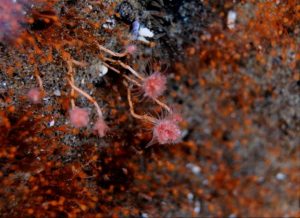


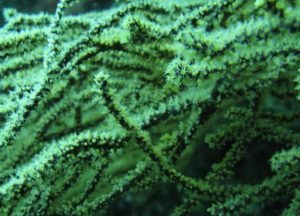




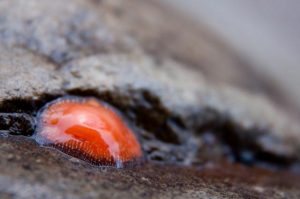


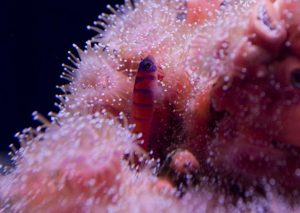


0 Comments